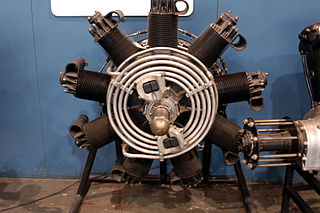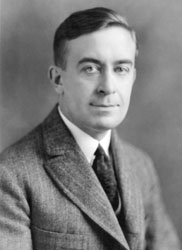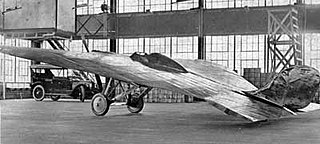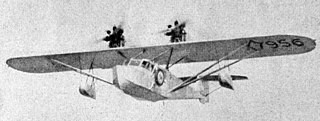Related Research Articles

A V12 engine is a twelve-cylinder piston engine where two banks of six cylinders are arranged in a V configuration around a common crankshaft. V12 engines are more common than V10 engines, however they are less common than V8 engines.
A variable-pitch propeller or controllable-pitch propeller (CPP) is a type of propeller with blades that can be rotated around their long axis to change the blade pitch. Reversible propellers—those where the pitch can be set to negative values—can also create reverse thrust for braking or going backwards without the need to change the direction of shaft revolution.

Axial engines are a type of reciprocating engine with pistons arranged around an output shaft with their axes parallel to the shaft. Barrel refers to the cylindrical shape of the cylinder group whilst the Z-crank alludes to the shape of the crankshaft.

Grosse Ile Municipal Airport is a public airport located two miles (3 km) south of the central business district of Grosse Ile, in Wayne County, Michigan, United States. It is owned by the Township of Grosse Ile. It is included in the Federal Aviation Administration (FAA) National Plan of Integrated Airport Systems for 2017–2021, in which it is categorized as a local reliever airport facility.
The Buhl Aircraft Company was a US aircraft manufacturer founded in Detroit in 1925 with operation until 1933. Buhl designed and manufactured the Buhl-Verville CA-3 Airster, first aircraft to receive a US civil aviation type Certificate in March 1927. Several utility and sport aircraft models were developed from 1925 to 1931, both fixed wings and rotary wing aircraft. Relative success came with the Buhl Airsedan and Buhl Bull Pup, with manufacturing numbers over one hundred sixty from 1927 to 1932.

Max Bentele was a German-born pioneer in the field of jet aircraft turbines and mechanical engineering. His contributions to the development of the Wankel engine earned him the title, "Father of the Wankel Engine in the United States".
The Verville Aircraft Company was a Detroit, Michigan based manufacturer of small airplanes and flying boats, which became bankrupt during the Great Depression. Alfred V. Verville started the corporation after working for multiple aviation companies. An innovative corporation, it could not survive the difficult financial crisis of the early 1930s. The Verville Aircraft Company was located at 4815 Cabot Street, Detroit, Michigan, occupying the former Rickenbacker plant. Verville Aircraft was organized by Walter Briggs, Sr., president and chairman of Briggs Manufacturing Company. Barney Everett (Everitt) served as the president of the company. The treasurer was S. E. Poole.

The Packard DR-980 is an American nine-cylinder air-cooled aircraft Diesel engine first certificated in 1930. The engine was unpopular despite its economy and reliability due to the unpleasant nature of its diesel exhaust fumes and considerable vibration when running; approximately 100 were built.

The Packard 1A-2500 is an American V-12 liquid-cooled aircraft engine designed by Packard in 1924 as a successor to the World War I-era Liberty L-12. Five aero variants were produced, of which the 3A-2500 was the most numerous. Three marine versions, used most prominently in American World War II PT-boats, the 3M-2500, 4M-2500, and 5M-2500, were also derived from it.

Alfred Victor Verville was an aviation pioneer and aircraft designer who contributed to civilian and military aviation. During his forty-seven years in the aviation industry, he was responsible for the design and development of nearly twenty commercial and military airplanes. Verville is known for designing flying boats, military racing airplanes, and a series of commercial cabin airplanes. His planes were awarded with the Pulitzer Speed Classic Trophy in 1920 and 1924.
Stout Metal Airplane Division of the Ford Motor Company was an American aircraft manufacturer founded by William Bushnell Stout as the Stout Metal Airplane Co. in 1922. The company was purchased by Ford Motor Company in 1924 and later produced the Ford Trimotor. At the height of the Depression, Ford closed the aircraft design and production division in 1936, temporarily re-entering the aviation market with the production of the B-24, at the Willow Run aircraft factory during World War II.

The Stout Batwing was an experimental low aspect ratio flying wing aircraft developed by William Bushnell Stout. The aircraft used wood veneer construction and was an early example of cantilever wing design. The internally braced wing was also one of the first American aircraft designed without drag-producing struts.

The Stout Batwing Limousine was a single-engine, high-wing cantilever aircraft. It was also called simply the "Commercial Sedan".

The Stout ST was a twin-engine torpedo bomber built for the US Navy. It pioneered the American use of metal construction and the cantilever "thick wing" design concepts of German aeronautical engineer Hugo Junkers, themselves pioneered in the second half of 1915.

The Towle WC, aka Towle TA-1, was a custom built aircraft for a 1929 round-the world flight.
The Towle TA-2 was an amphibious aircraft based on the T owle WC built for a 1929 round-the world flight.

The Towle TA-3 was an amphibious aircraft based on the Towle TA-2.

The Eastman E-2 Sea Rover, also called the Beasley-Eastman E-2 Sea Rover, was a light seaplane built in the late 1920s for business and shuttle use.

Jesse Gurney Vincent was an American aircraft, marine, and automobile engine designer. Famed initially for his design of the World War I Liberty aircraft engine, he rose to enduring prominence as the longtime chief engineer for Packard automobiles.
References
- ↑ Robert F. Pauley. Michigan Aircraft Manufacturers.
- ↑ "Patent 1888335" (PDF). Retrieved 6 November 2011.
- ↑ ROBERT B. MEYER (1964). The First Airplane Diesel Engine: Packard Model DR-980 of 1928. SMITHSONIAN INSTITUTION • NATIONAL AIR MUSEUM WASHINGTON, D.C.